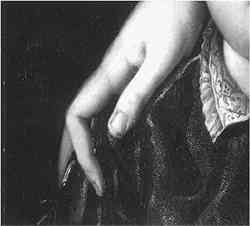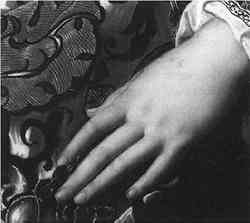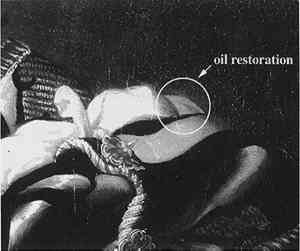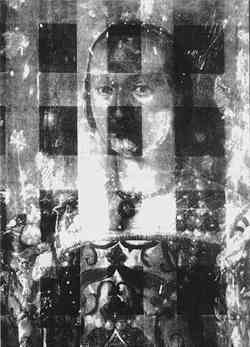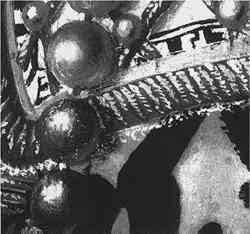EVIDENCE OF REPLICATION IN A PORTRAIT OF ELEONORA OF TOLEDO BY AGNOLO BRONZINO AND WORKSHOPSERENA URRY
5 TECHNICAL EVIDENCEThere are a number of technical indications that the Detroit portrait was painted by more than one hand. These include evidence of piecework fabrication, areas of misunderstandings in the division of labor, limited overlaps of paint, errors in extending the image, and simple copying errors. 5.1 PIECEWORK FABRICATIONOn close examination it is evident that the Detroit portrait was painted one section at a time. There are burrs, or small walls of dried paint, between the separate parts of the composition (fig. 5). Found throughout the Detroit portrait, these burrs are most visible at the intersections of the costumes with the faces or hands. The burrs of paint surrounding the heads of Eleonora and Don Giovanni, and especially their hands, are the most pronounced. These areas were carefully outlined and left absolutely in reserve as the rest of the composition was painted. The burrs were not disturbed by the slight overlap of paint from the reserved areas, indicating that enough time had passed for the paint on the initial parts of the composition to dry. Where there is a slight overlap of paint the underlying
5.2 BORDER MISUNDERSTANDINGSThat the various pieces of the composition were painted by different hands is indicated by two visible misunderstandings between the painters of separate areas. One of these areas is around Don Giovanni's head (fig. 7). The background painter left a reserve area for the head but along one side produced an irregularity in the contour. This irregularity now appears as a lump above Don Giovanni's ear, which the painter of the head has sparsely covered with fine strands of hair. The contrast to the hair painted on the background, above the irregularity, gives Don Giovanni the appearance of a bald spot on one side of his head. No doubt it is now more pronounced because of the darkening of the background.
The second border misunderstanding is at Eleonora's proper left shoulder. In the Uffizi portrait a small linen tag from her underblouse twists and loops over at the top of her shoulder (see fig. 2). The blue background is visible under the loop. In the Detroit portrait, the background painter has left a blank space for the loop, but the sleeve painter did not fill it (fig. 8). An old, irremovable oil restoration, a wedge of medium gray, now occupies the blank area, but the original light brown can be seen around it. Again, the area is more prominent because of the darkening of the background.
5.3 OVERLAPPED PAINTOf the several contributors to the Detroit portrait, the painter of the heads and hands was the only artist to impinge on other areas of the painting, as shown around Eleonora's proper left hand (see fig. 6) and at the side of Don Giovanni's head (see fig. 7). In addition, an x-radiograph of the Detroit portrait shows that the lower string of Eleonora's pearl necklace was painted on top of the dress, while the upper string was painted at the same time as her throat (fig. 9). Under magnification, the impasto of the dress's gold trim appears through one of the pearls in the lower string (fig. 10); in the same manner the overlapping paint around Eleonora's hands covers adjacent impasto. No overlaps of paint are found in other areas of the composition in the Detroit portrait.
5.4 ERRORS IN THE EXTENSION OF THE IMAGEThe Detroit portrait is on a larger panel than the Uffizi original, meaning that parts of the image had to be created rather than copied. The 6.5 cm expansion of the dress at the bottom of the Detroit portrait is one such area. At the bottom left corner of the skirt in the Uffizi portrait, the top of one of the large gold brocades shows at the very edge of the panel (see fig. 2). These motifs appear regularly over the fabric. Examination of the fabric pattern shows that the brocade at the bottom edge is a duplicate of the motif on Eleonora's torso. At the bottom left of the Detroit portrait, however, it dissolves into a lumpy chevron where it has been extended to fit the larger panel (see fig. 1). It is unlikely that the skirt painter ever saw the fabric or the dress itself but was working directly from the Uffizi portrait. By inference, it is unlikely that this painter was Bronzino, who demonstrates a good understanding of the fabric in the original portrait. 5.5 COPYING ERRORSSimilar misinterpretations of the original occurred in copying directly from the Uffizi portrait. For example, the landscape at the center right of the Uffizi portrait shows a river curving around the green shore on the right side (see fig. 2). In the Detroit portrait the river and shore have been transformed into an amorphous whirlpool (see fig. 1). Simpler misinterpretations of the original design are also present. In the vertical fold of the skirt at the lower right, beside the red bench, a black line of cut velvet jumps over two folds rather than following the contours of the satin (fig. 11). The same general effect of the black design lying on top of the draped satin can be seen throughout the skirt in the Detroit portrait, particularly when it is compared to the handling of the design in the Uffizi portrait.
|
